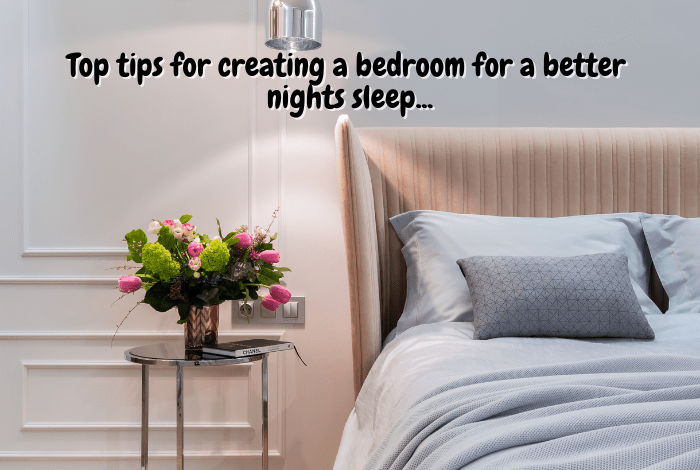Everyone knows the importance of getting a great night’s sleep. However, sometimes it can be easier said than done. Perhaps you’ve tried a night routine with no success. Maybe, you’ve even minimised all external factors like noise and light from outside.

If you’ve tried a few things, but are still struggling to get restful sleep, it may be time to rethink your design. From choosing the right colours to optimising your lighting, there are a range of different ways to create a more sleep-friendly environment that will leave you feeling refreshed and rejuvenated each morning.
Looking for inspiration? We’ve got a handful of tips and tricks below to help you design your bedroom for better rest and rejuvenation.
Prioritise sleep with your bedding
Think back to the last time you stayed in a hotel, and likely how well rested and relaxed you felt. Chances are, they had gorgeous bedding with fluffy pillows and a mattress that you just melted into. From a mattress that suits your sleeping position to bedding, your sleep surface should be tailored to your specific needs. Here are a few things to keep in mind:
- Like your mattress, your pillows should also be unique to you and your sleeping needs. Think about how you sleep, choosing a pillow that supports you throughout the night.
- When choosing a quilt, consider your climate and whether you run warm. From there, choose a fabrication that suits. Cotton is a great option for those who are looking for a breathable quilt, while Alpaca offers extra warmth for cooler temperatures.
- Consider switching out your sheet sets with the seasons. With options like cotton and linen, there are plenty of different options to suit your sleep needs.
- Don’t forget about a mattress protector, It can help improve your mattress hygiene.
Think about other furniture
With your bedding taken care of, it’s time to turn your attention to other bedroom furniture. While a bed is the star, other furniture like dressers and shelves can act as great storage solutions, while also complementing your overall design. Dressers and wardrobes play a crucial role in helping keep your space organised and decluttered. With everything in its space, you may find it a little easier to relax.
For those who are particularly challenged by limited space, choosing the right bed can make all the difference. A space-saving small double ottoman bed not only provides a comfortable sleep surface but also includes built-in storage underneath. This type of bed is ideal for smaller bedrooms, allowing you to maximize your floor space without sacrificing functionality or style. The additional storage can be perfect for stowing away bedding, seasonal clothing, or other items, helping keep your bedroom neat and conducive to relaxation.
Bedside tables can also enhance the functionality and comfort of your space, plus they’re a great way to show off some personal decor items. Pair them with your bed frame and have a great place to rest your book or tea as you begin to unwind for the night.
Create the right sleep environment
Another important aspect of designing a bedroom for better sleep is the sleep environment. From light to sounds and temperature, there are plenty of things to consider:
- Lighting. Try and block out light by closing your blinds and even investing in blackout curtains. If you prefer to sleep with light, try one with a red or orange hue, as these colours have been shown to have a calming effect on the body.
- Temperature. Is your room feeling a little cold? Or perhaps too warm? Try and set the temperature before you curl up into bed.
- Declutter. Another factor that can affect your sleep environment is how cluttered your space is. Take some time to declutter and organise your space.
- Storage. Consider investing in storage solutions like under-bed storage containers or hanging organisers to maximise your space and keep everything in its place so that every time you step into your bedroom you feel relaxed.
Create a bedtime routine
Once you’ve got your space just right, you might want to consider winding down with a bedtime routine that will help you relax. This process can signal to your body that it’s time to wind down and prepare for sleep and can be helpful for those who struggle to switch off at night. Your routine will be personal to you, but here are a few general tips to get you started:
- Avoid caffeine.This stimulant can make us feel more alert, making it harder to switch off and fall asleep. Instead opt for a caffeine-free option a few hours before bed.
- Stick to a sleep schedule. This means going to bed and waking up at the same time – even on the weekends.
- Try relaxing activities. This can be anything from gentle yoga to a warm bath or even reading a book – anything that helps you switch off.
- Avoid screens. Relaxing activities are also great for keeping you away from a screen before bed.
- Write down your thoughts. Journaling can be a great way to bring the day to an end. Whether you write down your thoughts or want to plan out the day ahead, jotting down some words can be a great way to help your brain switch off.
Designing a calm and cosy space is essential in helping you get a better night’s sleep. By prioritising sleep with bedding tailored to your sleep needs, carefully choosing your colours and setting the right environment, you can create a space for relaxation and rejuvenation. Add in your bedtime routine and you’re set for sleep!
Don’t miss out on future posts like this – receive updates directly to your inbox by email by adding your email address here and hitting subscribe. You can also follow me on Twitter or BlogLovin and I’d love to see you over on my Facebook page and on Instagram. If you’re interested, you can find out more about me here and while I’ve got your attention, if you’re wondering why some of my posts lately are a little bit less frugal then have a read of this post. 







 Logging you in...
Logging you in... Loading IntenseDebate Comments...
Loading IntenseDebate Comments...

slither io · 65 weeks ago